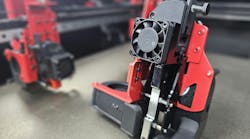Railcar unloading systems Hamilton Plastic Systems provides customized turnkey systems, including conveying systems, storage silos, in-plant blending equipment and all auxiliary equipment involved with emptying railcars of powders and pellets. The company can supply manual or automatic conveying line switching stations, and single- or double-pump systems, or large filter receivers, along with customized controls.
What’s new? Availability of Hamilton’s smart Railcar Unloading Control, which allows users to control all railcar unloading systems, airlocks, directional valves and silo monitoring systems from one touch-screen display. The system, which makes automatic adjustments without operator intervention, now comes with railcar unloading setups from Hamilton.
Benefits Decreased labor costs and faster unloading times. The system lets users optimize railcar unloading, so that all resins are conveyed in a way that prevents damage. Typically, trains are unloaded front to back, and with existing systems, cars in the front can be unloaded too quickly while cars in the back can be emptied too slowly. These conditions can lead to material damage, such as the creation of angel hair. By contrast, the Railcar Unloading Control optimizes all conveying pumps to suit the material and its position in cars on the tracks.
Hamilton Plastic Systems Ltd., Mississauga, Ontario, 905-890-0055, www.hamiltonplasticsystems.com
Vital Statistics
|
Maximum power of central vacuum pressure pumps |
100 horsepower |
|
Conveying rates |
Over 50,000 pounds per hour |
|
Available line sizes |
3, 4, 5, 6 or 8 inches |






